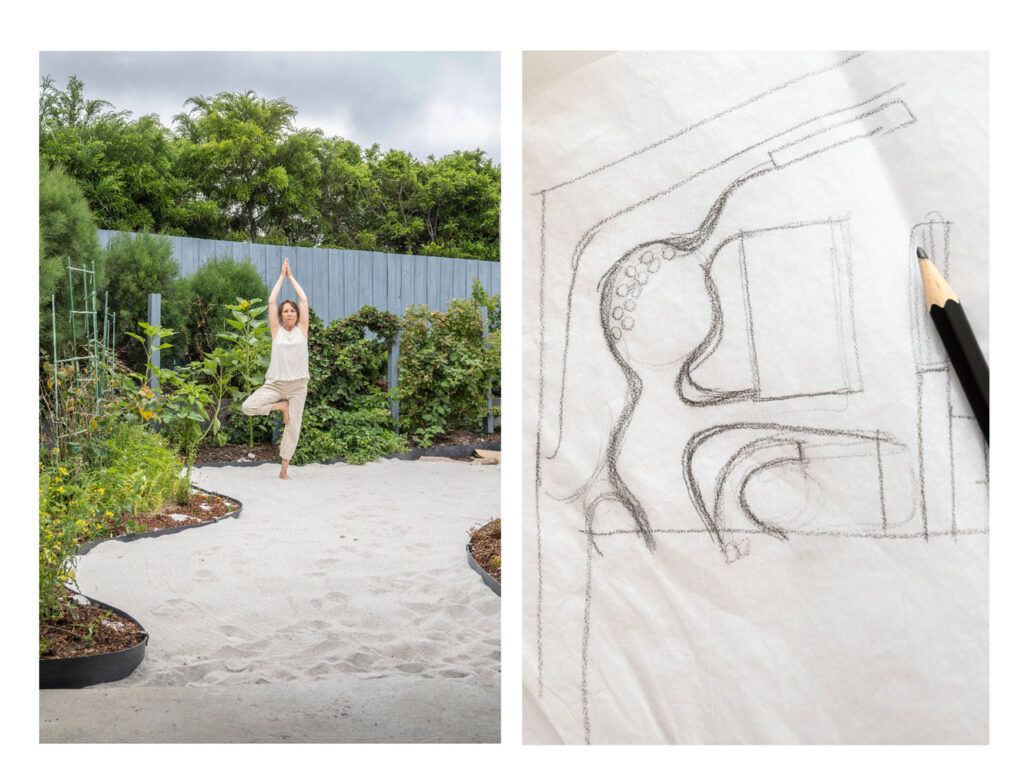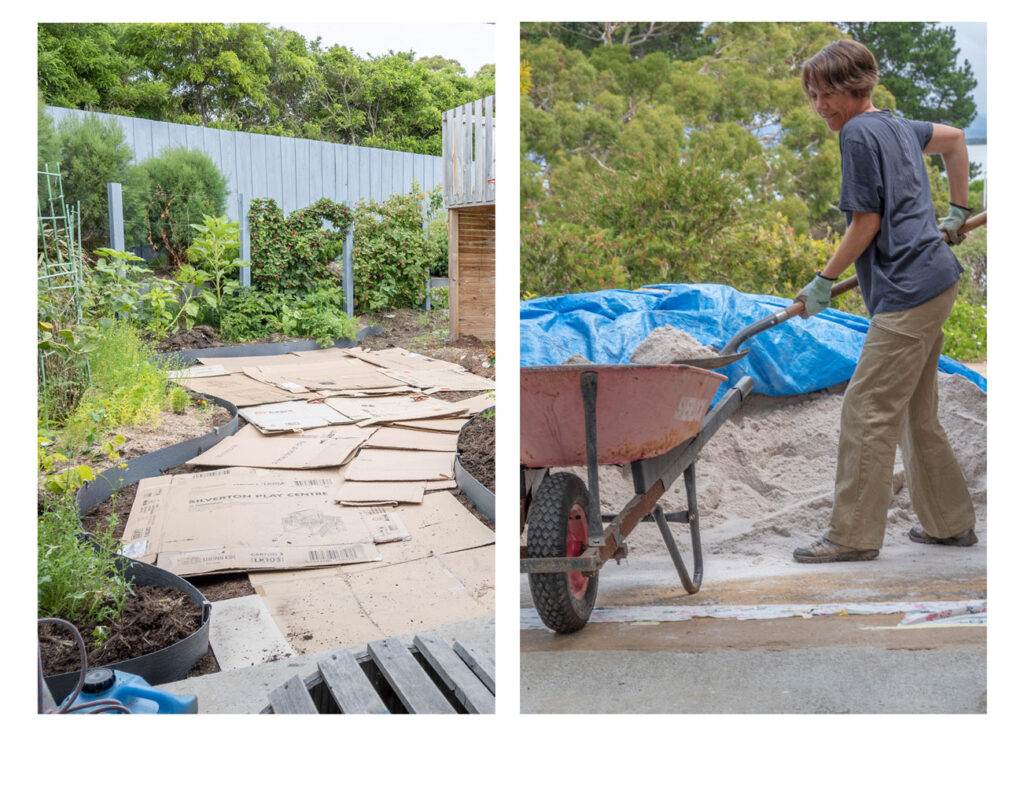Contents
- 1 From a Building and Landscape Designer Hobart
- 2 Concept Design: Blending Elements for a Harmonious Space
- 3 Listen to Nature for Inspiration
- 4 Choosing materials that say coastal and encourage fun and relaxation
- 5 Grip and Safety for Encouraging New Activities
- 6 The Lush Productive Garden
- 7 The Feel of a Native Coastal Garden
- 8 Attracting Wildlife
- 9 The Key to Low Maintenance Garden
- 10 Now It's Your Turn to Create
From a Building and Landscape Designer Hobart
Concept Design: Blending Elements for a Harmonious Space
For the concept design, I combined various elements: a beach, a coastal outdoor yoga and meditation retreat, a children’s sandpit, a playground, a creative terrace, a lush productive garden, and a coastal natural reserve walk.
Experimenting in my garden is a joy, and I love trying new things as our family’s needs evolve. Pushing the boundaries of conventional design and materials is part of the nature of landscape designers. Being open to experimentation allows us to create spaces that are both functional and beautiful.
Listen to Nature for Inspiration
After diving deep into research on the key elements of naturally occurring coastal gardens and reserves, I decided to view them with fresh eyes, as if seeing them for the first time. I noticed that sand paths and small, flat sand dunes surrounded by low grasses, flowers, and shrubs were guiding me on how to structure my garden and what to place at its center.
My endless beach and bush walks became a source of inspiration as I observed how water collected around these sandy areas, creating lush green patches that contrasted beautifully with the bare sand shifting with the wind and tides. With this concept in mind, I sketched out my vision for the garden. Excitedly, I shared my idea of transforming our backyard into a beach sand dune fun space with my family, and they were all on board. With their enthusiastic support, I got started right away.
Choosing materials that say coastal and encourage fun and relaxation
Selecting the right materials was a crucial part of the project, particularly the sand. We visited several landscape material providers, testing their sands by climbing their sand piles barefoot and collecting samples in little bags. It was a fun experience, and having the options at home allowed us to discuss and see them in place. We had to act quickly, as our little sample bags soon became a sandcastle in the garden, with my child playing with them.
For my yoga practice, I wanted a sand that provided safety and grounding and in my experience practicing yoga on a mat inside a building or on a terrace floor gives you the opposite feeling. I wanted to feel the soil on my toes and experience the kind of grounding that reduces inflammation, connects you with the earth, and supports relaxation during meditation. Whether you agree with the science of grounding or not, I find that people perceive a better connection when barefoot on a natural material directly connected to the soil. It shifts perceptions and enhances the experience.
I chose bunker sand, the type used in golf clubs, for its beautiful white colour, feel, stability, and because it doesn’t compact. It’s size is coarse enough to stay in place without drifting too much in the wind or sticking to our feet and clothes, yet fine enough to feel soft and pleasant to the touch. This sand connects us with nature, enhancing the overall experience.
Grip and Safety for Encouraging New Activities
The sand needed to offer grip to hold my yoga poses without sliding and provide a soft landing if I fell (which I often do). These features allow me to be more daring in my practice, hold positions longer, and relax without focusing on potential injuries. Creating something customized for your own needs is essential when designing a concept and choosing materials.
The sand also supports sports not typically practiced at home, like gymnastics, beach volleyball, and beach soccer. My child is now trying new sports, doing handstands, and using the yoga ball, all thanks to the versatile sandpit.
The Lush Productive Garden
Surrounding the sand circle and path is a productive garden designed in layers, from short to tall. Closest to the sand are carrots and small flowers like marigolds, followed by taller flowers such as sunflowers. On their trellises, berries create a lush wall of fruit. Behind them, native South Esk pines stand tall and evergreen, with Tasmanian native ferns and Dianella grasses at their feet, thriving in the shade. All of this is set against a darkish grey timber fence.
Designing in layers and combining flowers, natives, and foliage adds aesthetics, texture, and ensures something is blooming in all seasons, protects the smaller plants from wind and harsh conditions, and helps keep the sand in place.
The Feel of a Native Coastal Garden
Next time you are on a coastal walk, observe how it feels and how nature creates spaces that are stable and flowing despite harsh conditions. In southern Tasmania, where we live, coastal walks feature coarse, compacted beige sand with small flowers and bushes, followed by taller trees providing shade. The paths are winding and zigzagging, offering glimpses of what lies ahead. This inspired me to create a similar path-like feel from the house into the larger sand area, with round edges blending plants into the sand and sand into the bush, reminiscent of the national parks I love exploring with my family.
Attracting Wildlife
A garden is as alive as the life it supports at all levels: soil, plants, and the creatures that visit. Attracting wildlife like bees, butterflies, bandicoots, skinks, blue-tongue lizards, and native birds is essential. Wildlife helps maintain the garden’s health and adds to its beauty, creating a dynamic space with movement and unexpected visitors. It brings awe, inspiration, discovery, and learning, especially for children. I wanted to create a garden for exploring nature and wildlife, incorporating into my family life this feeling of being always surrounded by nature. Supporting local wildlife and the environment in our gardens was crucial in the design as we all wanted to help maintain the wildlife corridors in our neighbourhood and spread native seeds.
The Key to Low Maintenance Garden
Choosing a low-maintenance garden was all about freeing up time for yoga, meditation, and fun with the family. With less time spent on garden chores, I can dive into my three-hour daily yoga and meditation practice and enjoy precious moments with my loved ones.
The secret to reducing maintenance lies in picking the right plants, smart watering, and keeping weeds at bay. Instead of a lawn, I use sand with cardboard underneath to stop weeds and protect the soil. Garden beds are topped with plenty of mulch to control weeds and save water. A nifty drip irrigation system, connected to a tap that I turn on for just 15 minutes a day, keeps everything hydrated. This setup helps our productive and native garden flourish, conserving water, ensuring consistent watering during summer, and cutting down on maintenance. It’s a win-win for plant health and the environment, resulting in a lush, thriving garden.
Now It's Your Turn to Create
Experimenting with different elements and materials has been a rewarding journey. Our coastal retreat is now a space where each family member can relax, play, and connect with nature.
I invite you to create your own retreat. Start with a simple draft, just pencil and paper. Dare to experiment, dream, and envision your perfect space. Whether it’s a coastal retreat or another theme, let your imagination guide you. Happy designing!
Get Your Design Project Started With These FREE Resources to help you on your building designer journey
- Get Marisol’s FREE Book “How To Get The Most Out Of Your Home Designer…Even If The Designer is YOU” here.
- Watch Marisol’s FREE Workshop “Home Design Secrets” here. Would it be too out there for you to get started with your home and follow the same steps I followed to redefine my home? And how about me guiding you the same way I guide my clients when I design their houses? Step by step, you’ll find it all here.
- If you loved this blog and think of a friend or family member that would find it useful, please feel free to share it. And if someone forwarded yousigner | Home Designer | Interior Designer this article and you liked it, then you can sign up here for my newsletter.
- Marisol Miro Quesada works as a building designer, architectural designer, house designer, interior designer, and landscape designer specialising as home designer. Schedule a call to chat about your project or get a free quote here.

